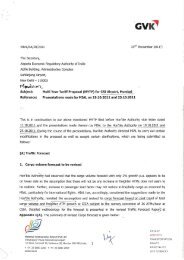Annexure II - AERA
Annexure II - AERA
Annexure II - AERA
Create successful ePaper yourself
Turn your PDF publications into a flip-book with our unique Google optimized e-Paper software.
NER A<br />
Economic Consulting<br />
"Given the different local circumstances and fast-changing conditions, with<br />
respect to airport ownership and management, as well as regulatory regime,<br />
there are likely to be a range ofdifferent appropriate treatments ofnonaeronautical<br />
income by sirports" (Emphasis added)"<br />
Common reading of these words would indicate that, in emphasising the importance that airport<br />
charges are able to ensure the full cost recovery of providing airport services, ICAO does not<br />
indicate explicitly which approach might be considered more appropriate to reach cost<br />
recovery. On this issue, ICAO recognises that the more appropriate approach to be followed in<br />
determining how costs are to be shared and at what extent revenues from non-aeronautical<br />
activities shall be taken into account, can not be identified per se, but it should be determined<br />
case-by-case, on the basis of the specific factors of each airport.<br />
Therefore, neither single till nor dual till or hybrid till are recommended or supported by<br />
ICAO. On the contrary, the regulatory till recommended by ICAO should be defined for<br />
each airport on the basis of characteristics and peculiarities of the single airport.<br />
As a consequence the conclusions drawn by <strong>AERA</strong>, according to which "single till is<br />
recommended or supported by ICAO,,6and that, consequently, this approach shall be adopted for<br />
all major Indian airports in an indiscriminate way, arise from an incorrect interpretation ofICAO<br />
policies.<br />
More specifically, ICAO, in emphasising the need for airport to recover its full economics costs<br />
associated with provision of airport services and in recognising that different treatments ofnon <br />
aeronautical income may apply to different airports, indicates that:<br />
"In general, three approaches have been used to describe how an airport<br />
recovers the full costs associated with the sirport and its essential nonaeronautical<br />
services. These approaches are commonly refereed to as: a) single<br />
till (sometimes referred to as the "residual" approach; b) dual till (sometimes<br />
referred to as "compensatory "); and c) hybrid till. "(Emphasis addedr'<br />
The above quotation confirms that, in laying down guidelines on methods to allocate nonaeronautical<br />
revenues to an airport's cost base, ICAO recognises the possibility to adopt<br />
different approaches, which range from a single till (where aeronautical costs are adjusted to<br />
reflect non-aeronautical revenues that accrue to the airport) to a dual till (where no adjustment is<br />
made to the aeronautical costs to adjusted to reflect non-aeronautical revenues that accrue to the<br />
Idem, page 4-15.<br />
<strong>AERA</strong> (2011), Order No. 13/2010-11 , In the Matter ofReguletory Philosophy and Approach In Economic Regulation of<br />
Airports Operators, par. 5.32.<br />
Idem, par. 4.55.<br />
<strong>Annexure</strong> <strong>II</strong>-B<br />
CP No. 9/2013-14/T-12023(14)/1/2012- Tariff- Vol - <strong>II</strong>I <strong>Annexure</strong> <strong>II</strong>-B Page 20 of 51<br />
3
















